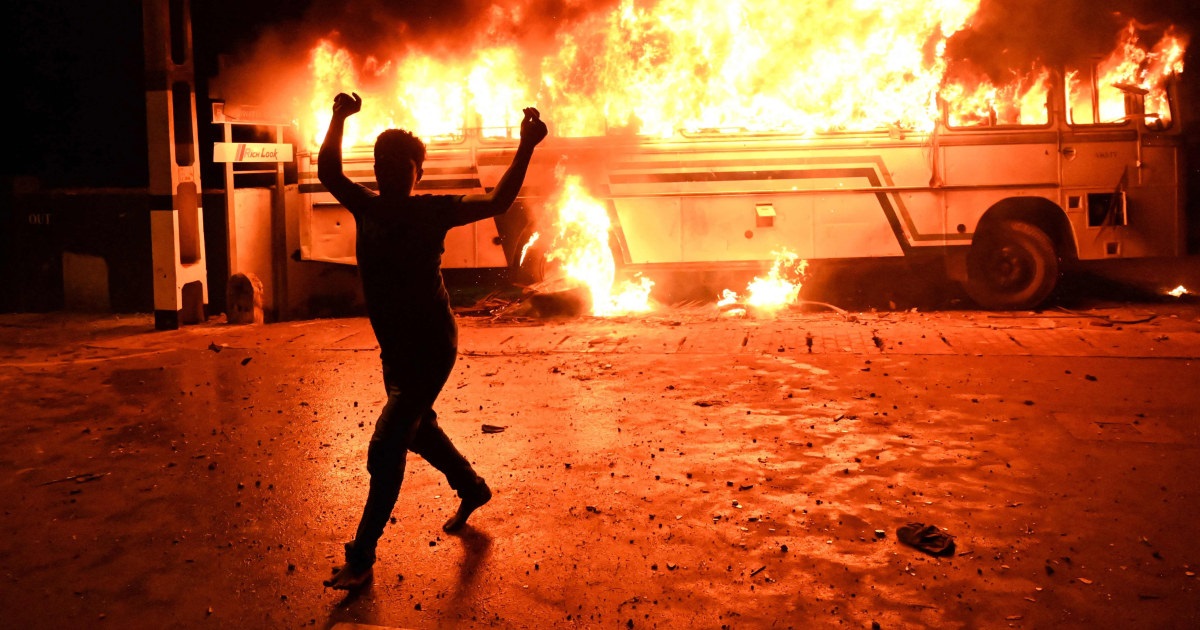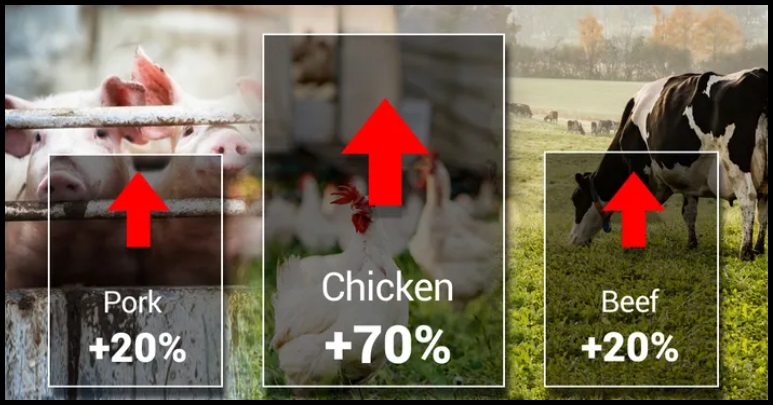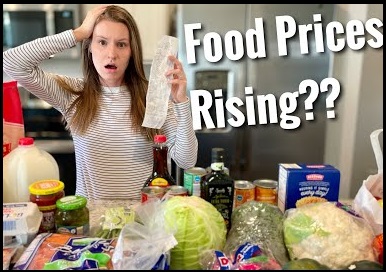I have stated for the past year ‘the absence of food will change things‘. The inflation and food affordability crisis has now surfaced in Sri Lanka. Global media is paying attention, even sending out warnings about what this might represent for other nations.
Sri Lanka has a debt to GDP ratio of 120%, approximately the same as the United States. However, Sri Lanka does not have the benefit of their currency being supported as the global trade currency; therefore, the debt and domestic inflation rate are directly tied together.

The rate of food inflation in March has exceeded 30%…. the absence of the public being able to afford food has now surfaced and the government is collapsing. Read the news from Sri Lanka through the prism of what could happen in U.S. cities if we lose the dollar as the global trade currency.
(Via Reuters) – Reuters Breakingviews) – Sri Lanka’s collapse is front of mind for many. Protesters fed up with crippling shortages of essential food and fuel items are on the streets, prompting multiple members of Prime Minister Mahinda Rajapaksa’s cabinet to offer to resign late on Sunday.
Social unrest will probably accelerate a restructuring of some $44 billion of international sovereign debt. Though Sri Lanka’s problems follow years of mismanagement, its speedy unravelling is a warning to sturdier economies from Europe to Asia suddenly grappling with a spike in the cost of living.
A current account crisis read more has intensified after the West fired its sanctions bazooka at Russia as punishment for its invasion of Ukraine. Rolling blackouts and a state of emergency are frightening away remaining tourists, a crucial source of foreign exchange. Food inflation hit an eye-watering 30.2% in March.
The currency’s 40% depreciation against the U.S. dollar in one month, including a central bank managed devaluation, is blowing out leverage ratios: Public debt estimated by the International Monetary Fund at 120% of GDP is perhaps some 40 percentage points more than might be deemed sustainable, guesses Citi.
[…] It’s a reminder of the political implications of high prices. Prior to Russia’s invasion of Ukraine, few Asian countries had consumer inflation in double digits. The standouts were Sri Lanka and Pakistan, whose Prime Minister Imran Khan on Sunday dodged a no-confidence vote and called fresh elections. Poorer countries are more vulnerable to surging global food prices because their populations spend more on food than discretionary items. (read more)
Food inflation in Sri Lanka reached 30%…. things start immediately collapsing.
Consider the recent projected rate of food inflation in the United States (wave 2, this summer):


.
We can never be sure what is going to happen to society in the U.S. However, I would be leery about being in a densely populated urban area when whatever it is, surfaces.
Part of the problem there is new laws that regulate organic farming, which have crippled the agricultural economy of the nation.
https://foreignpolicy.com/2022/03/05/sri-lanka-organic-farming-crisis/
what bob said.
What an oxymoron : Organic gardening.
Why do we fall for the government’s labeling?
Gardening is organic; just that act alone independently.
Government regulations formulated from their ‘experts’ based on a computer program somewhere in some federal office building is puking out the “organic part” definition.
It’s just another fun way to add more rules, regulations and $$’s to control a family so they will NEVER be self-sufficient. AND God help them if they defy Big-Gov; they will dump their milk and kill their stock and fine them $$’s and even put them in jail.
Define tyranny….
actually organic means no gmo grains, no pesticides other than the few they okay. Plus it costs a lot for the permits.
It means farming on your land with no permissions.
The Amish are the best Organic gardeners in the World. They are so good that they produce almost 60% as much as an industrial farm. So, if all farms went organic – 40% of the people would not eat.
I think it was more in relation to the organic fertilizer they were using.
We should change to name of the democrat party to,” the regulators”!
Nothing more organic than a riot
Just as the Demo☭rats’ ANTIFA and BLM are all warmed up
… for Catch-and-Release with Defunded Police
… and Open Borders for Invading Illegals.
Long past time to defend liberty. Long past!
Onward!
In honor of my friend from Ceylon. I see her gentle strength as she took her daily walk, praying her rosary, then stopping by at times to ask permission to use my computer. Her husband forbade her to get one or learn to type. She taught me about Ceylon. Dear, gentle, Berta. ♥️
cross posted at https://freedomaustralia.freeforums.net/thread/2094/sri-lanka-civil-chaos
This is almost funny if the topic wasn’t so serious. 65 year old here married to wonderful woman for almost 45 years. Six children and 12 GC. 1700 square foot house with basement, every inch of it occupied with s*** kids don’t want and items the missus could never part with. Doesn’t count the youngest son who resides with us with his stuff. After a lifetime of trying to grow a yard of decent grass, I tried again today. What did I find in the back of the crowed garage? 1 1/2 bags of FERTILIZER! Screw that lawn, call me Oliver Douglas!
Will be interesting to see if the absentee businesses will be defended. Criminals that seek food, gas, firearms, $ from non owner run businesses, the min wage employee, will be the most vulnerable.
Pleas folks. During a time of Global fertilizer shortages – where farmers cannot get enough fertilizer,
please do not fertilize your lawns for the next 3 years.
I don’t feel guilty of purchasing fertilizer for my lawn. Farms don’t buy fertilizer from Home Depot. But buy it now if you need it–the price is skyrocketing and it will soon be hard to find.
Just turn on any mainstream news program, open a window & let the BS blast out on your lawn & plants.
Fertilizers are plentiful. Just costly. I’m a farmer.
Play MSM for BS for your crops, too.
Good sound system; one time, long-term investment.
Can’t eat grass when people get hungry enough or it gets too expensive they want care where it comes from.
Green Acres IS the (best) place to be!
Coming soon to a neighborhood near you!
3 words STOCK UP NOW!!
might want to add a few silver miners to your portfolio. still on sale but not for long.
I like junk silver as a store of value and a means of barter.
Buy a modest reserve. Do not go out and panic buy everything in sight. Don’t buy 250 lbs of flour if you only use 10 lbs a year. PLEASE DO NOT HORDE!
When are things going to get better in the supply chain, food resources area? You cannot say, so getting extra is prudent at this point. Not to mention we will have neighbors that cannot buy extra because they do not have the money needed to buy or because prices get to high, so buying extra at current prices is the prudent thing to do.
Or barter that extra flour with other folks. Or maybe start a small business as the neighborhood bread baker.
I’m not panic buying or hoarding. I’m buying what I know we’ll use in quantity just like always.
When PA had shutdowns, and grocery stores were wiped out of anything easy, I bought little because all that was left was high priced.
I’m still stocking up and buying cases of things we’ll use while there is plenty on the shelf.
It’s not hoarding if everyone has the opportunity to buy and chooses not to.
Some countries will not know the shortages are happening unless the populace watches msm. Where I live we are self sufficient! Cheers!
3 more: GROW A GARDEN!
At least at the start, a good place to be is in a county with a shrinking population. I think our county 20 miles from interstate has a shrinking population of about 16,000. Shrinking for most of the last several censuses. Yes, bad for electoral politics….I guess good for rural living and protection.
Our rural NE NC county has a population of around 10,000. Feeling pretty safe here.
German supermarket chain Aldi raises food prices 50% overnight:
https://citizenfreepress.com/breaking/major-german-grocer-raises-prices-50-percent-overnight/
Tell no one you have prepped. If you have, set up a “show pantry” with old canned items and broken solar lanterns. Hide your real doomsday pantry, preferably having more than one location.
The roaming goons that will show up will just destroy your food. If it’s a government agency, they will confiscate everything and take it elsewhere to destroy.
Don’t you plan on defending yourself and your home? I don’t get your comment. If there are roaming goons who have come to destroy your food, what do you think they will do to you?
Much here.
Note from 30k feet, once currencies and debt lose the battle with inflation, the nations become chaotic.
This is a long time brewing but escalates rapidly until it’s exponential. No country/currency avoids this spiral once it loses grasp of inflation.
With reserve currency, it happens even faster as countries who relied on the reserve currency look for alternate vehicles as the reserve currency loses value.
And this is where US is now as Russia is leading the way off the US dollar.
For those who believe The Russia-Ukrainian War is about Ukraine, they have no clue.
And yes, everything will get more expensive as your currency has less value.
The interesting thing is how the US maintains its military, Medicare, Medicaid, EBT, SS, etc. when it can no longer print money.
We should all assume there will be no SS or Medicare as we have known them when the dollar loses it’s reserve status. And we are going to have to cut everything else massively.
Meanwhile we have millions of third worlders crossing the border every few months now. This is going to be really bad.
It’s important to have a stock pile of needed medication, especially if you are a diabetic. Even if you have to pay cash.
A very small 12 volt fridge run off a small solar generator could help those who need to refrigerate their meds. The solar set up could help with a cpap machine, too.
Be happy! Don’t worry 😉! President Trump with our help will right the ship.
If they cut SS there will be NO America worth living in…
SMILE…
I recall being criticized and literally laughed at for prepping on a modest but thoughtfully adequate scale . Food water med supplies emergency medical books ammunition and delivery systems . Survival instruction books because we live in easy walking distance to a forest !
Yep I was a joke till the ANTIFA/BLM riots looting and arson in a city about 30 minutes away by highway .
Then my family understood I did not buy a fire extinguisher because I’m going to have a fire , a gun because I want to harm people however self preservation and protection of what one has amassed to survive and your self & loved ones law or no law it’s a divine right to defend your existence !
Inflation Protests Erupt Across Peru As President Imposes Curfew, Calls In Military
APR 05, 2022
https://www.zerohedge.com/political/inflation-protests-erupt-across-peru-president-imposes-curfew-calls-military
Global industry is only going to produce enough fertilizer to support 6 billion people over the next year or so. The US will be mostly OK. The rest of the world is screwed.
What would you call a good buffer zone /distance between a densely populated urban area and safety?